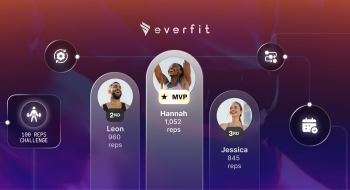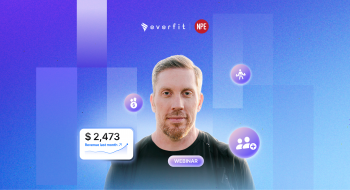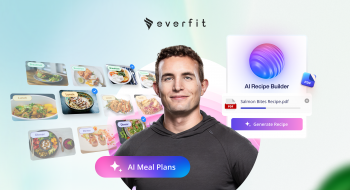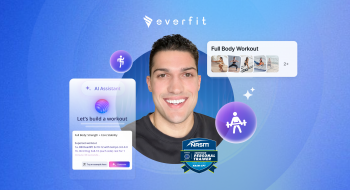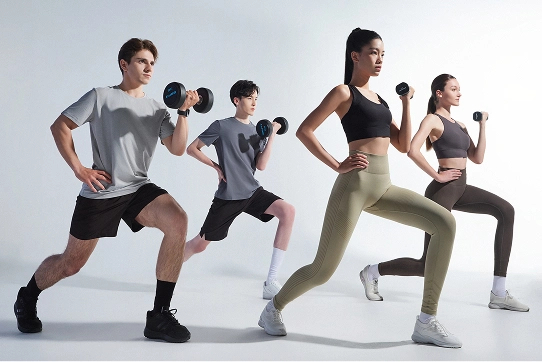Trevor Short is an exercise physiologist at the University of Hawaii, previous coach to NFL / Olympic athletes, & previous COO of a multi-million dollar training studios. Now he’s teaching you the essential concepts of designing a fitness program. You’ll learn how to perform a needs analysis & a comprehensive assessment, the foundational principle of designing a fitness program, and ancillary topics in exercise prescription. Learn the essentials of programming to the next level with these key considerations.
Transcript
And before we go there, I think it’s really important to consider the basic principles of exercise prescription. So how to create an exercise program, and really how to optimize your time spent on the Everfit platform, okay, and how to create a really solid, effective program to improve your clients lifestyle, strength, performance, whatever that might be. So we have the fit VP principle, this comes from acsm guidelines. But basically, you have some really, really basic and simple principles that underlie how programs can be modified and how they can be created. So you have the frequency, ie, how often does someone train, you have the intensity, this can be how hard this can also be considered the load. You have time duration, or how long they’re training type, the mode or what type. So type could be elliptical bike, treadmill, or it could also be resistance training, plyometric training, and so on, you have total volume, which is the total amount. So total volume can be quantified by a really common way to do it is just total pounds moved in a session, aka sets times, reps times the weight, right? So you can basically take that approach and quantify total volume. The other ways to quantify total volume might include ground contact times and something like plyometrics. So this is really giving a value to the total volume associated with the training session. And then progression. So how are you planning to progress your clients from a week to week, month a month microcycle to macrocycle level, how are you progressing your client from where they are today, towards their goal, whatever that might be from six months a year from now, whenever it is, what is your game plan and approach to progressing that athlete or individual to reach that specific performance level. And more specifically, we’re going to go take it back slides a little out of place, we’ll go into the principles now of the that we talked about earlier. So with this, let’s first let’s dive into intensity, so how hard intensity or load. So with this, we have, if you have the individuals one repetition maximum, right, the percent of their one RM is a good way to gauge the intensity. So this will give you a week. So the nsca National strength conditioning Association, these are block categories. So if you train less than 67%, it doesn’t mean that you’re not going to get hypertrophy, and that you’re not going to improve strength. However, you’re going to mostly be improving endurance, if you’re training less than 67% of one rep. If you’re training between 67 to 85%, you’re going to have a big hypertrophic adaptation, it’s not to say that you’re not going to improve endurance or not improve strength. And if you’re training higher than 85%, you will be increasing an individual strength, as well as gaining the hypertrophy. hypertrophic adaptation, that you would be getting the 67 to 85% range. Okay, so these are generalizations, but it’s really important to know, okay, where is my individual training based on their percent one RM? Am I gonna periodize them from an endurance training block to a hypertrophy block to a strength block? Right? How do you want to load this individual, how do you want to progress, you’re loading the individual through their intensity. Other ways to measure intensity would be an RP. So I like an Everfit RP or find RP is present, I’ll actually prescribe an exercise for an individual, let’s say bench press. So set one is going to be a six out of 10. RP, set two is going to be a seven out of 10. Set three is going to be an eight, set four is going to be a nine. So let’s say that four sets of five, right on that last rep, I want them to be at a 678 and nine out of 10. So the good thing about that is this is a solid way to auto regulate program design and help your athletes feel sort of feel where their predicted percentages 60% 70% 80% 90% might be based on that, that load and intensity. So another way to track intensity is through the RP. And then for endurance program prescription or just for conditioning, cardio type loads, heart rate is a really, really good way to measure intensity, and more specifically, heart rate zones can we’ll talk about that more in just a little bit.
The other thing we talked about is total volume, okay. So total volume is the amount. So total volume, some variables measured that, excuse me, some variables that are used to measure volume, you have your sets and reps because you can move By the sets, how many sets is individual that times how many reps that they did, right? combine that with their total weight, okay, then you know their total pounds or kilograms in that training session specifically, you can also quantify total volume by time. So this is really important to track for stress and strain progression, as well as periodization. Alright, so when considering aerobic program design, some of the other variables that are included in Everfit platform you have time, so, you’re going to have this individual run for 10 minutes, 30 minutes, hour, two hours, whatever it might be, you have the speed to if they’re using a treadmill, this is a really good way to prescribe someone to train at a specific speed, or pace, cadence. So cadence is how many steps in individuals taking per minute, right, and then you have the distance, if they’re doing long distance training or short distance training, aka are they going to be doing repeated Sprint’s or repeated 200 meter workouts or you’re going to have them do a long, slow training style session? All right. Another variable that’s really, really important to consider that can really change the scope of a workout session is rest time. So rest time, I think is something that a lot of coaches, practitioners aren’t measuring as much as they possibly should. And more specifically, it’s really important to measure rest time, because rest, right, the longer that you have rest, the more ATP that the body will be able to regenerate and utilize in that next set. Okay. So with that, yes, that can be important. If you want to improve someone’s overall quality. For example, if you really want to improve someone’s vertical jump, you probably should not have them doing really, really short arrest type loads, or short rest intervals with high loads, because they’re not going to be able to jump as high as they possibly can, by the time that they’re redoing that next exercise of that next sets, you want to have a long, a long work to rest ratio there to allow them to fully perform. Whereas if you want to apply a bioenergetic stress, right, if you want to get somebody really conditioned and improve their average power output, or average force output, for average movement quality, right, then having a shorter rest time will be good, because this will have more of a bioenergetic demand. So this all goes back to the needs analysis, what is the work to rest ratio of this individual, what are their needs, are they really, really fit within the phosphagen system, but they have really, really poor cardio, do they need better cardio, are they still subpar with the phosphagen system, and so on. So having a really, really good needs analysis will directly translate into how you prescribe rest time. So with this to go over this table, really quickly, we have four primary energy system pathways, they were the phosphagen system, which occurs all out movements from zero to 10 seconds. Proper work to rest ratio here is 112. So let’s say you assign an individual a 10, second sprint, for example, a 10 seconds all out sprint to optimize the work to rest ratio with this should be a one to 12. So that 10 seconds, multiply it by 12 120 seconds, two minutes. So 10 seconds on two minutes off, 10 seconds on two minutes off, sounds like a long, long rest period, right. But if you consider all out full body stimulus, aka a 10 second sprint somewhere around 100 meters at 200 meters, right, that’s going to be a lot of stimulus. And they’re gonna actually really need that two minutes to recover. And as you transition down the columns here, you can see that we work from the phosphagen system fastqc localytics, so glycolytic to the oxidative system. And again, the work to rest ratios kind of decrease with that load and intensity specifically. So phosphagen system out with the most intense oxidative system bout would be least intense. So it takes more time to recover from phosphagen about right than it would to recover from a oxidative bout. If they’re the same duration. However, they have different durations. But all in all to make sure that you get the primary takeaway here is that based on how long you’re prescribing exercises, right, there are optimal work to rest ratios zones. And this is specific to improving somebody’s performance, right? Not necessarily their energetic capacity. So for example, something like Tabata 20 seconds on 10 seconds off, right? That does not fit into this work to rest ratio column here from the nsca. However, what that’s going to do is really stress the bioenergetic system, right? And so the bioenergetics will have a big functional lab patient from that individual become a lot more fit from that from a bioenergetic standpoint, but maybe not from a peak power output or peak performance.






